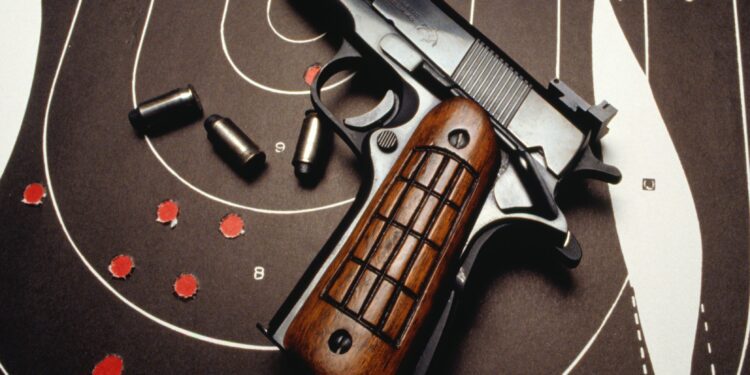As a former Marine and ER physician, I come to the gun debate with a dichotomous perspective. The United States of America is unique in many ways. Two of which are that we are the only wealthy nation without a public healthcare system that cares for the entire population and we have more privately owned firearms than there are people. Some see the number of guns available in this country as a public health risk.
The Constitution, however, enshrined the right to own and bear arms, second only to speech and the free press, somewhat settling the debate – but not completely. The devil’s always in the details. Anyone who reads what the founders were thinking clearly knows that the Second Amendment existed because they did not want a permanent standing army. Today, Switzerland is the closest thing to what America’s founders wanted in this regard: well-trained and armed citizens who could defend the nation without the threat of a permanent military and its possible use against the citizens. These trained civilians would be called “the militia.” The Amendment goes on to also say “well regulated”, which implies mandatory training. But this seems to have conveniently fallen by the wayside.
The US has always been contrarian. It was founded after all, by men willing to break the law, who took up arms against an oppressive authority. Jefferson’s words have kept alive the belief that this might be necessary again. Guns were also crucial to every citizen’s safety on the frontier. Not least because the people already living in the Americas were not keen on going quietly into that dark night so that immigrants from Europe could fulfill what they called their manifest destiny. Despite all the changes in America, Jefferson’s words still echo as loudly now as they did then.
America has also been the place you can go with a good idea and some hard work and end up with wealth and acclaim. Repeating rifles, manually operated like the Kalthoff repeater, were developed in Europe as far back as the 1630s in Denmark. The first patented version in 1640 held a magazine of eight to ten rounds and was lever action. You still needed to pour in some powder and tamp it down, however. Paper cartridges had been in use as far back as the 1300s. But these had to be muzzle-loaded and tamped down. Perhaps for this reason, these guns did not become widely used in Europe until US inventors discovered that combining metallic cartridges with repeating firearms increased the gun’s usefulness against native peoples who were much faster with a bow than the invaders were with their muskets.
Diseases had devastated native populations in the East, making the remaining survivors easy prey for single-shot weapons. But by the time expansion made it to the Great Plains, some tribes had been able to rebuild a large enough population to be a real problem for the “settlers.” Christopher Spencer, with his famous repeating rifle design, found the solution for the American West: a lever action rifle that used metallic cartridges. At that moment, everything changed.
Innovations in gun-making quickly moved from Europe to the US, where other inventions like the Gatling gun, an early hand-cranked machine gun, changed the balance of power forever. Used first at the Siege of Petersburg, Virginia, during the Civil War, it proved devastatingly effective. Mr. Gatling said that he created it to reduce the size of armies and consequently, reduce the number of deaths by combat and disease, trying to show the futility of war. In this aim, Mr. Gatling failed miserably. But the gun companies prospered, and the American firearms industry was born. In 2022 alone, 16.4 million firearms were sold in the US, contributing $51.3 billion to the American economy, making it an industry worth about $28 billion while employing almost 170,000 people.
Most Americans come to the gun debate from one of two angles. Those who believe we must be able to own and carry a gun. After all, the Civil War proved that those with the most advanced weapons have an advantage should a political debate turn violent. And those who feel the continuous mass shootings prove that the time for an armed American citizenry has passed. Most of the former, though not all, grew up in a rural area, where guns are seen as a rite of passage, and the occasional shooting was remote in frequency and effect. The latter tend to come from an urban area, where the daily gun deaths of innocents are blared across screens and guns seem to have become an unnecessary evil.
This disparity is much less than the polarizing press would have us believe. Note that 33% of those living in rural areas think gun ownership reduces safety while 34% of those in urban environments think it increases safety. That being said, you are still statistically more likely to die by your own gun than someone else’s. Suicide by gun has always been one of the major problems with gun ownership: 54% of all gun deaths in 2021 were the result of suicide, 43% were murder, and the remaining 3% were attributed to accidents. That being said, the US has a rather high murder rate, and 80% of all murders in the US involve a gun. That seems like a problem to me, though not to everyone.
I had someone recently tell me how terrible the stabbing deaths in Europe are and how the victim having a gun would have helped. What they failed to mention is that if the assailant had a gun, it would have been much worse. You can run from or fight back against a knife much more effectively than you can a firearm. So, after listening to all of this, you probably expect me to say something along the lines of how gun deaths are at a record high and the US should ban guns. On the contrary!
Gun deaths are not at an all-time high when put in perspective, and just a few common sense measures could do a lot of good. Even in the Old West, they didn’t hand “Crazy Joe” shooting iron, due to his rights and all, nor did they hand a rifle to the Younger brothers when they left the hoosegow. But they didn’t have the ability to regulate gun transactions safely. We do. I also don’t think we should try to outlaw guns in this country. There are around 494 million firearms in America today. Remember, the US only has a population of around 330 million people. Of those, about 45% of American households own a gun, telling us we have some very well-armed households. And most of those households, following Mark Twain’s advice to support your country always, and your government when it deserves it, don’t trust the authorities to ensure their safety.
In fact, one in three Americans believe that violence against the government can be justified. Guess which side of the gun ownership angle they fit into. Sending federal agents to round up guns like they did in Australia after the Tasmanian massacre would result in a catastrophe that would leave this nation in tatters.
Even the American military would have individuals in rank-and-file positions opposing the plan. It would turn into Civil War Part II. We’d prove that the paranoids were not delusional but prescient. Gun violence in America is terrible, no doubt. With the death of every innocent comes the ending of an entire universe, and it often seems like we’re headed in the wrong direction with no hope in sight.
But beneath the media’s sensationalized rhetoric, we find a few interesting numbers. The rates of gun-related murders are lower now than it was in the early 1970s: 7.2 deaths per 100,000 people then, compared to 6.7 in 2021. But firearm deaths still account for a disproportionate number of American deaths, including children. Shootings where the child gets hold of a gun are at an all-time high. What has changed? When I was a child in the 70s, the National Rifle Association taught gun safety classes and was in favor of reasonable gun restrictions. It was in their financial interest not to be blamed or associated with gun deaths. Then came congressional protection from liability. That’s when things changed.
Today, the more people who die by the gun, the more guns the industry sells. It’s sickening. At the same time, the gun lobby stokes public fears that the government is coming for your guns, causing those who fear being unarmed to hoard and stockpile armories in their basements; you know, “just in case.”
What can we do better? Return back to the days where gun education was a big part of gun culture. We should have mandatory gun safety classes in schools with dummy firearms. It’s not as crazy as it sounds. Remember the words, “well-regulated militia”. To me, that means a well-educated public. Think of it like harm reduction applied to gun violence.
I also believe that we should remove the industry’s absolute immunity from liability. This gives them skin in the game, so to speak, making them more likely to emphasize educational and safety initiatives.
And lastly, we must enforce background checks on all firearm transactions, period. I know it’ll aggravate the whole gun show crowd. But keeping at least some guns out of the hands of the mentally ill or criminally inclined should not be too much to ask.
I await the verbal stomping I’m sure to receive for making such outrageous suggestions, but there it is.
















Dr. Parker,
I’m glad I read the whole thing. I agree with your suggestions about what we should do, except for the education part.
I do agree with accepting the reality that we have more guns than people, and you aren’t going to take them away. That’s an unfortunate position to be in as a society.
I’m not sure what the point of showing that there are fewer murders than in 1970. It is still a slaughter.
Then I take some issue with your interpretation of the second amendment
The second amendment is the one-sentence amendment.
Saying “Anyone who reads what the founders were thinking clearly knows that the Second Amendment existed because they did not want a permanent standing army.”
Using the word “clearly” and the hyperbola of saying “Anyone” is rhetorical that skips over the complexities of the fact that the amendment is only one sentence in length.
I would argue that what you can surmise from that one sentence should be limited to what the sentence says.
I have never seen any other way to read it as the right to bear arms is a clause that is dependent on the primary subject or clause which is the the need for a well-regulated militia. End of story.
We do have the National Guard.
I think the idea of having educational classes about gun safety and use is something that would spawn a huge industry and not change much. In fact, that might make things worse.
Learning calculus or taking a class in horseshoeing and then not doing those activities doesn’t at all mean that you’ll be able to do those activities at a moment’s notice. It’s been well demonstrated that when people who aren’t practiced at gun use and then put in an emergent situation react poorly.